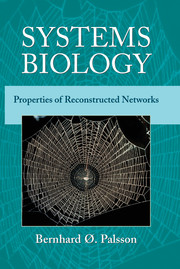Book contents
- Frontmatter
- Contents
- Preface
- 1 Introduction
- 2 Basic Concepts in Systems Biology
- PART I RECONSTRUCTION OF BIOCHEMICAL NETWORKS
- 3 Metabolic Networks
- 4 Transcriptional Regulatory Networks
- 5 Signaling Networks
- PART II MATHEMATICAL REPRESENTATION OF RECONSTRUCTED NETWORKS
- PART III CAPABILITIES OF RECONSTRUCTED NETWORKS
- APPENDIX A Nomenclature and Abbreviations
- APPENDIX B E. coli Core Metabolic Network
- Bibliography
- Index
4 - Transcriptional Regulatory Networks
from PART I - RECONSTRUCTION OF BIOCHEMICAL NETWORKS
Published online by Cambridge University Press: 05 September 2012
- Frontmatter
- Contents
- Preface
- 1 Introduction
- 2 Basic Concepts in Systems Biology
- PART I RECONSTRUCTION OF BIOCHEMICAL NETWORKS
- 3 Metabolic Networks
- 4 Transcriptional Regulatory Networks
- 5 Signaling Networks
- PART II MATHEMATICAL REPRESENTATION OF RECONSTRUCTED NETWORKS
- PART III CAPABILITIES OF RECONSTRUCTED NETWORKS
- APPENDIX A Nomenclature and Abbreviations
- APPENDIX B E. coli Core Metabolic Network
- Bibliography
- Index
Summary
The expression of the gene complement of a genome is carefully regulated. Only a fraction of the genes in a genome are expressed under a given condition or in a particular cell type. There is a complex transcriptional regulatory network that controls which genes are expressed in response to various environmental and developmental signals. Extensive effort is being devoted to the elucidation of the components of transcriptional regulatory networks and the links between them. The reconstruction methods that are being developed are based on both legacy and high-throughput data types, and notable progress is being made with a few specific cases. Although the comprehensive details are not yet available for any one transcriptional regulatory network, some of their fundamental principles have been elucidated and a conceptual framework for their hierarchical decomposition has been developed.
Basic Properties
The chemical conversions taking place in metabolic networks relate to the dismemberment and assembly of small molecules through a series of chemical transformations. In contrast, transcriptional regulatory networks involve the association and interaction of large molecules. They rely primarily on protein–protein interactions and DNA–protein interactions, although metabolites do participate directly in some of these transformations. The chemistry underlying these interactions is currently partially understood, but much progress is being made. Still, however, these networks are not as well assembled and characterized as metabolic networks.
- Type
- Chapter
- Information
- Systems BiologyProperties of Reconstructed Networks, pp. 54 - 73Publisher: Cambridge University PressPrint publication year: 2006



